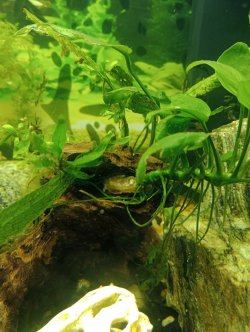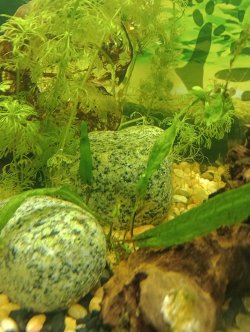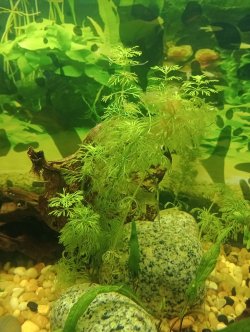Hi. I Have a 60 ltr Tank 6 Black neons, 5 Harlequin Rasbora, 5 Zebra Danio, 5 Nerite snails and Hundreds of small, what I believe to be Malaysian trumpet snails. The Tank has been well planted with a mix of limnophilia, Anubis and Java fern, I also have Sylvania Floating on the top. My issue is that something is destroying my plants, I noticed it first with the Sylvania, usually I'm removing hand fulls ever other week, but over the last few months it's disappearing, my java fern has bern eaten alive and now my limnophilia, I'm normally trimming every other week, is getting attacked. IV looked online and opinion differs but, I believe the culprit is the Zebras, my plants started to get atacked about the time I introduced them, but, as mentioned I have hundreds of Malaysian snails to, iv read that they don't eat plants but, being keen gardener I know the damage a snail can do. What do you guys think? Fish or snail or something Iv not thought of.
You are using an out of date browser. It may not display this or other websites correctly.
You should upgrade or use an alternative browser.
You should upgrade or use an alternative browser.
Mystary plant killer.
- Thread starter Ursula
- Start date
I have 2 Nerite snails in one of my aquariums and I do not have an issue with my plants being eaten. I have never owned trumpet snails, but I’ve kept neons and rasboras in the past without issue to my plants. I’ve never kept the danios. My opinion is the trumpet snails are hungry. Perhaps it starts as just cleaning the leaves for algae, then they just can’t stop.
None of your fish are plant eaters.
Do you fertilize the plants, and what's your water change routine? A population explosion of trumpet snails can be a disaster for water quality. Nerites will scavenge plants. I think you have to look at something in the set up killing the plants, and the snails just trying to profit from that.
I would try to figure out was killing the plants without looking to other inhabitants of the tank. There, hopefully, one of our many planted tank experts will check in with advice for a solution.
Do you fertilize the plants, and what's your water change routine? A population explosion of trumpet snails can be a disaster for water quality. Nerites will scavenge plants. I think you have to look at something in the set up killing the plants, and the snails just trying to profit from that.
I would try to figure out was killing the plants without looking to other inhabitants of the tank. There, hopefully, one of our many planted tank experts will check in with advice for a solution.
Hello. The first thing that comes to my mind is the water temperature. Aquatic plants can be very sensitive to warmer tank water. What is your water change routine? Nutrients need to be replaced regularly. Large, regular water changes will replenish nutrients lost to the plants and to the process of oxidation. Just a couple of things I thought about.
10
10
Interesting responses, unfortunately I can't get a Decent picture, I have moved my tank a few months back, to a warmer part of the room, the temp has always been a constant 25 c, and the plants dieing started before. I do a 10ltr change every week, and 20ltr 30% once a month. The idea that the snails are profiting from dieing plants makes sense. How can I tell if it is the tank itself killing the plants, is there a way to test? IV been dubious about adding fertilizer because of algi and my fish health.
Plant are not very sensate to water temperature. Many plants typically found in quariums will do well below 60 fahrenheit. They do have limits for hot water but probably can handle 90F. Snails won't kill Salvinia neither will temperature or water spray or high water current. High water current just slows the growth.
Your water has run out of plant nutrients. There are 14 nutrients plants need to grow. If just one of the 14 is missing the plants won't grow and willl eventually die. Plants also prefer that the nutrients be water soluble. If the nutrients are not soluble in water the plants cannot access them. So floating planets are very susceptible to nutrient deficiencies. So you probably will need to fertilize your water. Also do weekly water changes Many fertilizers don't have all 14 nutrients because tap water typically has enough. But in todays world not all tap water is the same. For tanks filled with RO water or distilled or rainwater you need to fertilize the water because commercial fertilizers won't work with very pure water.
The Nutrients plants need other the carbon hydrogen and lxoygen (which come from the air and water ) are: Nitrogen, potassium, Calcium, Magnesium, phosphate, sulfur, chlorine, iron, manganese, boron, zinc, copper, molybdenum, and nickel.. Nickel is the least used nutrient with plants only needing 1 part per billion. Nitrogen is the most used.
Sometimes you have identify a deficiency by just looking at the plant. So a picture of the plants would be helpful. but if you have a test kit check GH, nitrate, nitrite, and ammonia. The GH test kit is sensivte to only calcium and magnesium. You don't want to se zero. For the other if all are zero you have to add nitrogen.
Nitrogen and phosphate are critical to making DNA. So if your are short on either these two plant growth will quickly come to a stop. A difficiency in any one nutrient will also stop plant growth. Algae grows best when one or more nutrients are deficient. Most of the 14 nutrients can be added in exc less of need with willte risk of explosive age growth. I get best results by dripping phosphate and nitrogen into my tank daily. The rest I apply right after a water change. If phosphate levels are low hard green spot algae tends to dominate. Phosphate test kits are not helpful because they cannot tell the different between soluble and insoluble phosphate. Phosphate doesn't stay soluble for very long in most tanks. Plants need soluble phosphate. Salvinisa is sensitive to low phosphate. cyanobacteria and long green hair algae do best in water with with low micro nutrients (iron to
nickel). The trick is to maintain conditions in a tank Algea doesn't like but is favorable to plants. If you can achieve that plants will grow well and quickly whiles algae struggles.
TNC light fertilizer is probably your best bet beecause they amount of each nutrient in the bottle appears to match the ratios plants prefer. I have never used it because it is not available in North America. it doesn't have nitrogen, phosphate, calcium, chlorineor nickel. If you have a calcium or magnesium deficiency increasing you GH by 1 degree with any commercially available GH booster should be enough to eliminate a GH deficiency. Tap water will typically have enough sodium or potassium chloride in in to satisfy the chlorine need and nickel is typically present in tap water. Seachem sells bottle of nitrogen or phosphate that can be used to add nitrogen or phsophate.
Your water has run out of plant nutrients. There are 14 nutrients plants need to grow. If just one of the 14 is missing the plants won't grow and willl eventually die. Plants also prefer that the nutrients be water soluble. If the nutrients are not soluble in water the plants cannot access them. So floating planets are very susceptible to nutrient deficiencies. So you probably will need to fertilize your water. Also do weekly water changes Many fertilizers don't have all 14 nutrients because tap water typically has enough. But in todays world not all tap water is the same. For tanks filled with RO water or distilled or rainwater you need to fertilize the water because commercial fertilizers won't work with very pure water.
The Nutrients plants need other the carbon hydrogen and lxoygen (which come from the air and water ) are: Nitrogen, potassium, Calcium, Magnesium, phosphate, sulfur, chlorine, iron, manganese, boron, zinc, copper, molybdenum, and nickel.. Nickel is the least used nutrient with plants only needing 1 part per billion. Nitrogen is the most used.
Sometimes you have identify a deficiency by just looking at the plant. So a picture of the plants would be helpful. but if you have a test kit check GH, nitrate, nitrite, and ammonia. The GH test kit is sensivte to only calcium and magnesium. You don't want to se zero. For the other if all are zero you have to add nitrogen.
Nitrogen and phosphate are critical to making DNA. So if your are short on either these two plant growth will quickly come to a stop. A difficiency in any one nutrient will also stop plant growth. Algae grows best when one or more nutrients are deficient. Most of the 14 nutrients can be added in exc less of need with willte risk of explosive age growth. I get best results by dripping phosphate and nitrogen into my tank daily. The rest I apply right after a water change. If phosphate levels are low hard green spot algae tends to dominate. Phosphate test kits are not helpful because they cannot tell the different between soluble and insoluble phosphate. Phosphate doesn't stay soluble for very long in most tanks. Plants need soluble phosphate. Salvinisa is sensitive to low phosphate. cyanobacteria and long green hair algae do best in water with with low micro nutrients (iron to
nickel). The trick is to maintain conditions in a tank Algea doesn't like but is favorable to plants. If you can achieve that plants will grow well and quickly whiles algae struggles.
TNC light fertilizer is probably your best bet beecause they amount of each nutrient in the bottle appears to match the ratios plants prefer. I have never used it because it is not available in North America. it doesn't have nitrogen, phosphate, calcium, chlorineor nickel. If you have a calcium or magnesium deficiency increasing you GH by 1 degree with any commercially available GH booster should be enough to eliminate a GH deficiency. Tap water will typically have enough sodium or potassium chloride in in to satisfy the chlorine need and nickel is typically present in tap water. Seachem sells bottle of nitrogen or phosphate that can be used to add nitrogen or phsophate.
Last edited:
If you have lots of snails you are likely overfeeding your tank, which could be leading to water quality issues, in which case your water changes may not be sufficient. It sounds like there are a few things out of balance. Your plants need nutrients, which you can add, but you may also need to reduce what you're feeding and do larger water changes to reduce the snail problem.
We still need pictures of the plants to make sure they are true aquatic plants and not garden plants that some shops sell. If you have garden or marsh plants, they don't always do well underwater. Pictures would let us identify the plants and maybe spot the problem.
The Ambulia needs more light and fertiliser. The Anubias doesn't need as much light of fertiliser, and the Cryptocoryne falls in between them.
How long is the tank light on for?
Most plants need at least 8 hours of good light per day. You can have the lights on for up to 16 hours a day but fish and plants need 8 hours of darkness to sleep.
If you aren't using any aquarium plant fertiliser, try adding some.
How long is the tank light on for?
Most plants need at least 8 hours of good light per day. You can have the lights on for up to 16 hours a day but fish and plants need 8 hours of darkness to sleep.
If you aren't using any aquarium plant fertiliser, try adding some.
I have the light on between 6 - 7 hours a day, I will defo look to add more light and some fertilizer. Will this incorage algae?. Thanks Colin.The Ambulia needs more light and fertiliser. The Anubias doesn't need as much light of fertiliser, and the Cryptocoryne falls in between them.
How long is the tank light on for?
Most plants need at least 8 hours of good light per day. You can have the lights on for up to 16 hours a day but fish and plants need 8 hours of darkness to sleep.
If you aren't using any aquarium plant fertiliser, try adding some.
Extra light and fertiliser can encourage algae if it's not balanced. Algae grows from an imbalance in either light, nutrients or number of plants using the light and nutrients. If you have too much light, or too many nutrients, or not enough plants to use the light and nutrients, you get algae.
Increase the light by 1 hour per day and monitor the algae over the next 2 weeks. If you get lots of green algae then there is too much light or not enough plants to use the light.
If you don't get any green algae then increase the lighting time by another hour and monitor for 2 weeks.
If you get a small amount of green algae on the glass, then the lighting is about right.
Another way to see if the plants are getting sufficient light is to watch the Ambulia. When it has had enough light, it closes its leaves up against the stem. It starts at the top and works its way down the stem. When you see this happening, leave the lights on for 1 more hour then turn them off. Hygrophila species also do this.
Healthy Ambulia growing under bright light with lots of nutrients will develop leaves that are about 3 inches diameter and the top set of leaves usually goes a red brown colour.
When aquatic plants get bright light, they often produce small oxygen bubbles that come out of the leaves (algae does this too). This is called pearling and means the plant is photosynthesising.
Increase the light by 1 hour per day and monitor the algae over the next 2 weeks. If you get lots of green algae then there is too much light or not enough plants to use the light.
If you don't get any green algae then increase the lighting time by another hour and monitor for 2 weeks.
If you get a small amount of green algae on the glass, then the lighting is about right.
Another way to see if the plants are getting sufficient light is to watch the Ambulia. When it has had enough light, it closes its leaves up against the stem. It starts at the top and works its way down the stem. When you see this happening, leave the lights on for 1 more hour then turn them off. Hygrophila species also do this.
Healthy Ambulia growing under bright light with lots of nutrients will develop leaves that are about 3 inches diameter and the top set of leaves usually goes a red brown colour.
When aquatic plants get bright light, they often produce small oxygen bubbles that come out of the leaves (algae does this too). This is called pearling and means the plant is photosynthesising.
Latest Discussions
- Replies
- 0
- Views
- 62
- Replies
- 7
- Views
- 115




